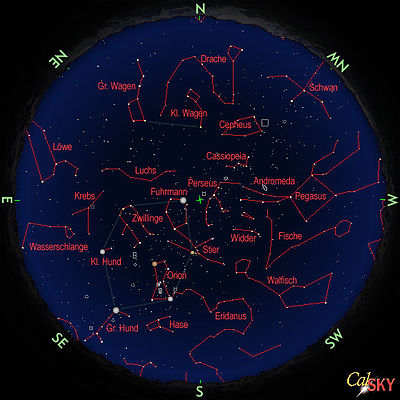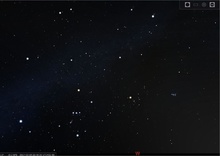Winter hexagon

Note : The picture shows the position 2 hours after culmination ; Two hours in front of her, Sirius is exactly below Betelgeuse, Prokyon much lower than Aldebaran, and Capella has almost reached the zenith.

(end of December 10 p.m., end of January 8 p.m. CET)
The winter hexagon is a striking constellation of bright stars of the first magnitude in the southern winter sky . It is not a constellation in the sense of the International Astronomical Union (IAU), but an asterism .
It consists of the following fixed stars (clockwise):
- Capella in the carter
- Aldebaran in the bull
- Rigel in Orion
- Sirius in the big dog
- Prokyon in the Little Dog
- Pollux in the twins .
The brightest star inside the hexagon, Betelgeuse (left shoulder star of Orion), forms an approximately equilateral triangle with Sirius and Prokyon - the winter triangle .
Sirius is the most southerly star with a declination of about −17 ° and Capella with + 46 ° is the one closest to the north polar star. Sirius and Rigel (−8 °) are both part of the southern star sky , the other part of the northern sky .
The winter hexagon can be seen from Central Europe from September (morning sky) to April (evening sky). In mid-December it will be around midnight in the south, and in mid-January around 10 p.m. CET . It can also be seen in large, light-polluted cities as it is made up of the brightest stars in this section of the sky.
Compared to a regular hexagon, the winter hexagon looks a bit “bent”, but it is approximately mirror-symmetrical in relation to the axis through the two brightest stars Capella and Sirius, which are opposite each other. These brightest stars also have the smallest angles of the hexagon, they correspond to about 90 degrees.
With a good pair of binoculars , some interesting objects can be observed in the area of the hexagon: the Orion Nebula below the Orion Belt , the two bright star clusters Pleiades (seven stars ) and Hyades (both in Taurus, each at least 100 stars, free-eyed 6-10) and two other star clusters : M35 at the end of the twins and M41 at Sirius. Furthermore, the Crab Nebula M1 (expanding gas cloud in Taurus, remainder of the supernova of 1054) and the Planetary Nebula NGC 2392 south of Pollux, as well as dozens of bright double stars in various colors.
Long-exposure astrophotography reveals numerous hydrogen clouds glowing in red in the western half of the hexagon, especially in the area of Orion. Most are extensive star formation regions , of which the Orion Nebula is the largest.
See also
Individual evidence
- ↑ Dr. Holger Kersten: The Winter Hexagon ( Memento from March 12, 2017 in the Internet Archive ).
- ↑ Space picture of the day (December 12, 2018): "Orion Falls" and star formation regions

